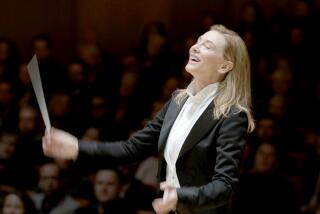Review: With violinist Patricia Kopatchinskaja, all bets are off
- Share via
Bartók wrote his Second Violin Sonata a year after Hungary formally ended its participation in World War I. The country was nearly bankrupt. Life was grim, but the Austro-Hungarian Empire was no more. Hungary had a full identity, and its greatest identifier was Bartók, who revolutionized its music by forging an interaction between folk music and modernism that provided inspiration for composers internationally to this day.
The sonata begins with the piano hitting a loud low F-sharp and the violin repeating what would sound like seven dissonant Es if they weren’t four octaves higher, and thus in their own worlds. Their lengths are slightly irregular. Asked to be played with expression, these Es begin at a modest volume and a very moderate tempo, getting quieter as they go along.
Bartók, whose marriage was falling apart and who wrote the sonata for beautiful Hungarian violinist Jelly d’Aranyi, was likely calming himself by seducing d’Aranyi. (He wasn’t the first composer with such intentions.) That is how these notes are played on his own recording of the sonata with his favorite violinist, Joseph Szigeti, and basically by all who have followed.
That is not how they were played by Patricia Kopatchinskaja, who began her highly anticipated Southern California recital debut Tuesday night with the sonata at Hahn Hall in Santa Barbara, as part of the UC Santa Barbara Arts & Lectures series. Each note might have had a question mark after it; each had something different to say; each had a different psychological makeup. One was gruff; another, consoling.
Kopatchinskaja was Bartók. She was d’Aranyi. Yet she was also on the outside looking in. The Es had the quality of taking deliberate deep breaths, with a nano-second pause for wondering whether any of them meant something or were worth playing. Yet Kopatchinskaja produced a propulsion toward a quietening peace so overwhelming, it seemed inevitable.
A review could be written about these seven Es alone, which lasted less than 20 seconds and were the first gesture of a uniquely questing, unsettling and often uncertain evening of music making. It goes without saying that this is a violinist who allows neither herself nor audience to take anything for granted.
Her dynamic pianist, Polina Leschenko, surely didn’t know what to expect either. After ruminating on the Bartók, Kopatchinskaja had a chair brought out so that she could presumably be at the same height as Leschenko and right next to the piano’s soundboard, which was fully up. The violin didn’t play over piano, as is the average violin soloist’s wont, and sometimes Kopatchinskaja didn’t even play along with the piano. Rather she absorbed Leschenko’s assertively grand sound into her own.
Kopatchinskaja followed the Bartók by attacking Poulenc’s Second World War Violin Sonata with feverish melancholy. She treated Romanian composer Georges Enescu’s Third Violin Sonata as though it were a toy box of folk instruments, each to be taken out and gleefully demonstrated. Then coming full circle, she provocatively confronted Ravel’s “Tzigane” as if possessed by d’Aranyi’s life-force, the Hungarian violinist also having been Ravel’s muse.
When it was all over, Kopatchinskaja announced that she had played an enormous number of notes for us, so her final encore would be an offering of silence. That came in the form of John Cage’s meditative 1947 Nocturne, the violin’s sustained notes played with icy tranquillity.
We commonly speak about the most intense musicians playing something as though it were life and death. We don’t really mean it. But when it comes to Kopatchinskaja, I’m not so sure.
She was a dumbfounding presence as music director of last summer’s Ojai festival, setting forth a shockingly vast range of music. She could seem as giddy as a guileless child or as profound as a deep thinker taking on the meaning of life, disease and the survival of the planet, along with the ultimate meaning of music, its history and being.
She never does the same thing the same way twice. She retained the same excitability Tuesday that can be heard in the Bartók, Poulenc and Ravel on “Deux,” her recent recording with Leschenko. But not for the same reasons. Every phrase comes alive as new life, not old life.
That meant questioning what works brilliantly on the recording. That meant maybe even her wondering why she was there. The Poulenc was played as though in a different, more pessimistic delirium. Not all the toys in the Enescu were put away, some were thrown away. In “Tzigane,” Kopatchinskaja reached a point of frenzy in which she appeared to want to lose herself entirely, and she is a great enough violinist that she can.
In fact, she is the great violinist who not only can, but who dares.
MORE ARTS:
St. Lawrence String Quartet’s rare, exhilarating marathon of early Haydn
Best theater 2018: Times critic Charles McNulty’s picks
Best art 2018: Times critic Christopher Knight’s picks
More to Read
The biggest entertainment stories
Get our big stories about Hollywood, film, television, music, arts, culture and more right in your inbox as soon as they publish.
You may occasionally receive promotional content from the Los Angeles Times.











